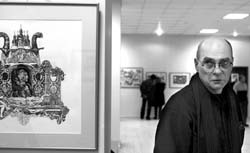Mazepa: An Unfinished Project?

The Kyiv-Mohyla Academy hosted a cultural function titled The Theme of Mazepa in Contemporary Ukraine’s Cultural Space.
The National University of the Kyiv-Mohyla Academy has formally announced the candidature of the Meritorious Painter of Ukraine Serhiy Yakutovych for the 2004 Taras Shevchenko National Prize of Ukraine in for the works he executed in 2000- 2003.
Mazepiana, Yakutovych’s enormous graphic series, occupied a prominent place at his personal exhibition in the Art Gallery of the National University of Kyiv Mohyla Academy. The series seems to have summed up the artist’s years-long reflections on Ukrainian and world history, our country’s victories and losses, the splendor and despair of the great epoch of baroque in Ukrainian culture — a time when Ukraine saw an upsurge, ruin, and the impasse of being a colonial appendage. Before that, the artist had taken part in making Yury Ilyenko’s A Prayer for Hetman Mazepa, one of the most bizarre Ukrainian movies. It is Yakutovych’s participation that made critics call this film a “piece of drawn cinema,” stressing the enormous role the production designer played in creating phantasmagoric images.
Mazepa has always occupied a special place in the Ukrainian minds. Today, too, he is considered a legendary figure invested with a very wide range of characteristic features and qualities and is often judged from diametrically opposed and stubbornly-held views. Moreover, all this creates the myth of Mazepa, a myth that embraces a very broad spectrum of opinions about Ukraine’s history, its people’s mentality, etc.
For centuries, Mazepa’s personality has been portrayed in various genres of art, in the works of the masters of diverse nationalities, creative schools and trends. He drew the attention of Voltaire who devoted to him a sizable part of his essay on Carl XII. Victor Hugo composed a long poem that caused quite a ripple in European literary circles. Lord Byron wrote a phenomenal poem that touched off an avalanche of paintings by Delacroix, Gericault, et al. Poland also saw great literature written about Mazepa. There is also now access to original Ukrainian sources.
All this helped create quite a broad spectrum of views on Mazepa. Still, what we know about him remains too contradictory and in fact insufficient, given the place of this figure in today’s Ukrainian life and the fact that he set an extremely important precedent of how to implement the idea of Ukraine’s presence on the map of European history.
The Theme of Mazepa in Modern Ukraine’s Cultural Space function, organized in the Kyiv- Mohyla Academy’s culture center together with Kino-Teatr magazine, was in fact an artistic attempt to resolve these contradictions. The function included Yakutovych’s exhibition as well as the viewing of Yury Ilyenko’s film A Prayer for Hetman Mazepa and the appearance of prominent culture figures, such as Vadym Skurativsky who said that Ilyenko had made “the most paradoxical movie” in the history of world cinema.
The film show was followed by a lively debate. Striking differences in the tonality of utterances and nature of opinions proved again that the phenomenon of Mazepa still remains, so to speak, an unfinished project of national history, and functions, like the one held at Mohyla, are steps toward its completion.






